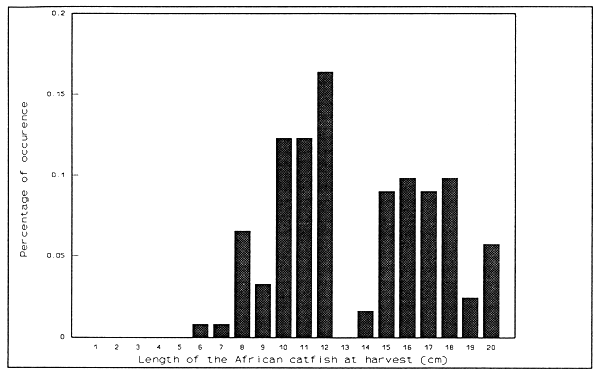Three factor are of importance once nursing takes place in earthen ponds;
The availability of large quantities of zooplankton.
The stocking density of the of the 3 day old larvae.
The duration of the rearing period.
The most critical factor for successful nursing of the African catfish is the availability of zooplankton during the first week after the ponds are stocked with hatchlings as they feed only on live food (de Graaf et al., in press, see Annex 1). This can only be obtained if the ponds are well fertilized. In Congo Brazzaville the ponds were filled and fertilized with dry chicken manure at a rate of 50kg/100 m2 one week before stocking.
With this procedure a nice phytoplankton bloom occurred prior to stocking and the pond water contained in general 1.5–2ml of zooplankton per 100 litre of water and had a secchi disk depth of 20–25 cm.
Feeding of the catfish must start immediately after stocking and the feeding rate is 1 kg of rice bran per 100 m2. The following feeding rates are recommended in case a composed feed is used ( with fish meal as animal protein source);
| First week: | 0.50 kg/100 m2/day |
| Second week: | 0.75 kg/100 m2/day |
| Third week: | 1.00 kg/100 m 2/day |
| Fourth week: | 1.25 kg/100 m2/day |
| Fifth week: | 1.50 kg/100 m2/day |
A major problem can be the presence of tadpoles. Tadpoles of the species; Rana occipitalis (Gunther 1858), Ptychadena pumilio (Boulenger 1920) and Xenopus tropicalis (Gray 1864), which are probably also present at the fish farms of the project, are phytophagous; they feed on phytoplankton only.
However their presence is a nuisance as they compete for the food resources in the pond; they feed on the phytoplankton which is needed for the development of zooplankton, which is on its turn needed for the growth and development the catfish larvae. There are two ways to solve the problem:
Protect the pond against frogs and tadpoles. Surrounding the ponds with aluminium roof plates (80 cm high) proofed to be very successful in Congo Brazzaville.
Remove the largest part of the tadpoles with a small mesh size seine net at the day the catfish larvae are stocked, as has been done in the Central African Republic.
The optimal stocking density of larval catfish is 100 per square meter. After 5 weeks 35–40 fingerlings per square meter can be harvested each weighing 2–3 gram (de Graaf et al., in press, see Annex 1). Increasing this stocking density does not increase the production. Lower stocking densities will result in less fingerlings per square meter but the harvested fingerlings will be bigger in size.
Note: In order to get the right stocking density, the number of 3 day old larvae,
harvested from the happa's has the be estimated. The easiest way to do
this is with a glass and a experienced operator can easily handle 10.000
larvae in 20 minutes.
It is also possible to estimate the number of larvae volumetric, as 1 ml
contains 150 larvae. The disadvantage of this method is that the larvae can
be damaged by the used sieve which results in high mortalities after they
are stocked in the nursery ponds.
A major factor which is influencing the success of the nursing phase is the length of the rearing period. Four to five weeks after stocking two distinct groups of catfish are found in the pond (see figure 5):
A large group (80–90% of the biomass) consisting of small sized fingerlings with an average size of 2–3 gram.
A small group of fingerlings (10–20% of the total biomass) consisting of large size fingerlings (8–10 gram)
Cannibalism will occur (the bigger sized fish will eat the small ones) if the two groups are not separated and you will finally harvest a very small number of large fish.
Under adequate management, an average survival rate of 30–40% can be obtained.

The frequency distribution of fingerlings of the African catfish, harvested from nursery ponds in July 1994 at the Yala fish farm in Kenya
Note: If 100 larvae are stocked per square meter and it is essential to harvest your fingerlings 35–40 days after stocking otherwise the large fingerlings will eat the small ones
In un-protected pond tadpoles must be seined out before the pond is stocked. Aquatic insects such as water-scorpions, water-beetles, water-boatman and larvae of the dragon fly can be controlled with kerosene. The kerosene should be poured, in the early morning, along the windward side. The breeze will cary the fuel across the water which will prevent the aquatic insects from taking air at the surface and they will soon die.